Chapter 6: Syntax-Directed Definitions and Translations
5.7 EXAMPLES
The examples that follow further illustrate the concepts covered within this chapter.
| |
Construct an SLR(1) parsing table for the following grammar:

First, augment the given grammar by adding a production S 1 ’ S to the grammar. Therefore, the augmented grammar is:

Next, we obtain the canonical collection of sets of LR(0) items, as follows :
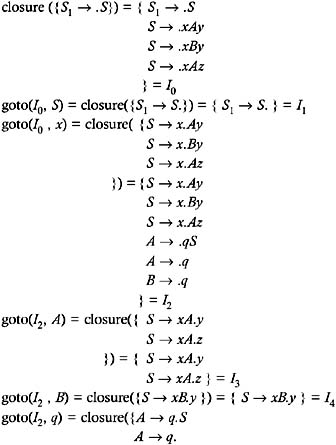
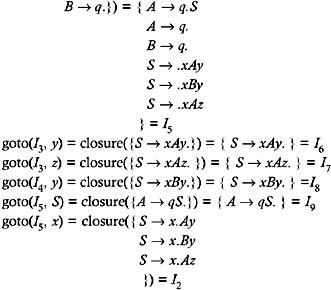
| |
The transition diagram of this DFA is shown in Figure 5.19.
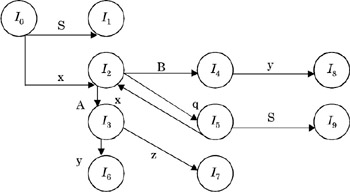
Figure 5.19: Transition diagram for the canonical collection of sets of LR(0) items in Example 5.3.
The FOLLOW sets of the various nonterminals are FOLLOW( S 1 ) = {$}. Therefore:
-
Using S 1 ’ S , we get FOLLOW( S ) = FOLLOW( S 1 ) = {$}
-
Using S ’ xAy , we get FOLLOW( A ) = { y }
-
Using S ’ xBy , we get FOLLOW( B ) = { y }
-
Using S ’ xAz , we get FOLLOW( A ) = { z }
Therefore, FOLLOW( A ) = { y, z }. Using A ’ qS , we get FOLLOW( S ) = FOLLOW( A ) = { y, z }. Therefore, FOLLOW( S ) = { y, z , $}. Let the productions of the grammar be numbered as follows:
The SLR parsing table for the productions above is shown in Table 5.11.
| Action Table | GOTO Table | |||||||
|---|---|---|---|---|---|---|---|---|
| x | Y | Z | q | $ | S | A | B | |
| I | S 2 | R 3 / R 4 | 1 | |||||
| I 1 | Accept | |||||||
| I 2 | S 5 | 3 | 4 | |||||
| I 3 | S 6 | S 7 | ||||||
| I 4 | S 8 | |||||||
| I 5 | S 2 | R 5 / R 6 | R 5 | 9 | ||||
| I 6 | R 1 | R 1 | R 1 | |||||
| I 7 | R 3 | R 3 | R 3 | |||||
| I 8 | R 2 | R 2 | R 2 | |||||
| I 9 | R 4 | R 4 | ||||||
| |
Construct an SLR(1) parsing table for the following grammar:
First, augment the given grammar by adding the production S 1 ’ S to the grammar. The augmented grammar is:
Next, we obtain the canonical collection of sets of LR(0) items, as follows:
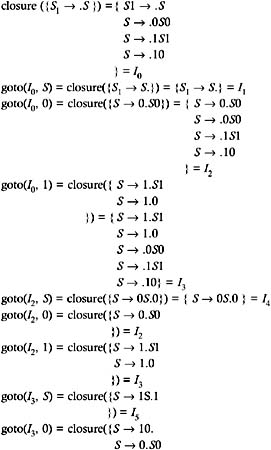

| |
The transition diagram of the DFA is shown in Figure 5.20.

Figure 5.20: DFA transition diagram for Example 5.4.
The FOLLOW sets of the various nonterminals are FOLLOW( S 1 ) = {$}. Therefore:
-
Using S 1 ’ S , we get FOLLOW(S) = FOLLOW( S 1 ) = {$}
-
Using S ’ S 0, we get FOLLOW( S ) = { 0 }
-
Using S ’ 1 S 1, we get FOLLOW( S ) = {1}
So, FOLLOW( S ) = {0, 1, $}. Let the productions be numbered as follows:
The SLR parsing table for the production set above is shown in Table 5.12.
| Action Table | GOTO Table | |||
|---|---|---|---|---|
|
| 1 | $ | S | |
| I | S 2 | S 3 | 1 | |
| I 1 | accept | |||
| I 2 | S 2 | S 3 | 4 | |
| I 3 | S 6 | S 3 | 5 | |
| I 4 | S 7 | |||
| I 5 | S 8 | |||
| I 6 | S 2/ R 3 | S 3 / R 3 | R 3 | 4 |
| I 7 | R 1 | R 1 | R 1 | |
| I 8 | R 2 | R 2 | R 2 | |
| |
Consider the following grammar, and construct the LR(1) parsing table.
| |
The augmented grammar is:
The canonical collection of sets of LR(1) items is:



The parsing table for the production above is shown in Table 5.13.
| Action Table | GOTO Table | |||
|---|---|---|---|---|
| A | B | $ | S | |
| I | S 2 | S 3 | R 3 | 1 |
| I 1 | Accept | |||
| I 2 | S 5 | S 6 / R 3 | 4 | |
| I 3 | S 8 / R 3 | S 9 | 7 | |
| I 4 | S 10 | |||
| I 5 | S 5 | S 6 / R 3 | 11 | |
| I 6 | S 8 / R 3 | S 9 | 12 | |
| I 7 | S 13 | |||
| I 8 | S 5 | S 6 / R 3 | 14 | |
| I 9 | S 8 / R 3 | S 9 | 15 | |
| I 10 | S 2 | S 3 | R 3 | 16 |
| I 11 | S 17 | |||
| I 12 | S 18 | |||
| I 13 | S 2 | S 3 | R 3 | 19 |
| I 14 | S 20 | |||
| I 15 | S 21 | |||
| I 16 | R 1 | |||
| I 17 | S 5 | S 6 / R 3 | 22 | |
| I 18 | S 5 | S 6 / R 3 | 23 | |
| I 19 | R 2 | |||
| I 20 | S 8 / R 3 | S 9 | 24 | |
| I 21 | S 8 / R 3 | S 9 | 25 | |
| I 22 | R 1 | |||
| I 23 | R 2 | |||
| I 24 | R 1 | |||
| I 25 | R 2 | |||
The productions for the grammar are numbered as shown below:
| |
Construct an LALR(1) parsing table for the following grammar:
The augmented grammar is:

The canonical collection of sets of LR(1) items is:
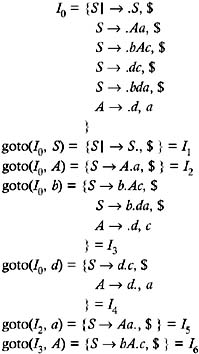
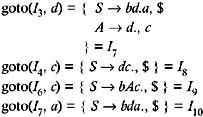
| |
There no sets of LR(1) items in the canonical collection that have identical LR(0)-part items and that differ only in their lookaheads. So, the LALR(1) parsing table for the above grammar is as shown in Table 5.14.
| Action Table | GOTO Table | ||||||
|---|---|---|---|---|---|---|---|
| a | b | c | d | $ | S | A | |
| I | S 3 | S 4 | 1 | 2 | |||
| I 1 | Accept | ||||||
| I 2 | S 5 | ||||||
| I 3 | S 7 | 1 | |||||
| I 4 | R 5 | S 8 | |||||
| I 5 | R 1 | ||||||
| I 6 | S 10 | S 9 | |||||
| I 7 | R 5 | ||||||
| I 8 | R 3 | ||||||
| I 9 | R 2 | ||||||
| I 10 | R 4 | ||||||
The productions of the grammar are numbered as shown below:
-
S ’ Aa
-
S ’ bAc
-
S ’ dc
-
S ’ bda
-
A ’ d
| |
Construct an LALR(1) parsing table for the following grammar:

The augmented grammar is:

The canonical collection of sets of LR(1) items is:
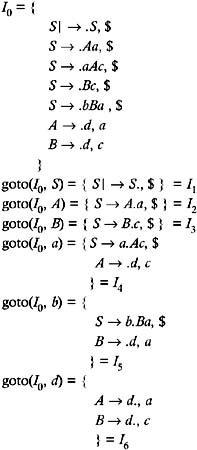
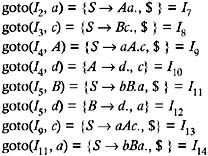
| |
Since no sets of LR(1) items in the canonical collection have identical LR(0)-part items and differ only in their lookaheads, the LALR(1) parsing table for the above grammar is as shown in Table 5.15.
| Action Table | GOTO Table | |||||||
|---|---|---|---|---|---|---|---|---|
| a | b | c | d | $ | S | A | B | |
| I | S 4 | S 5 | S 6 | 1 | 2 | 3 | ||
| I 1 | Accept | |||||||
| I 2 | S 7 | |||||||
| I 3 | S 8 | |||||||
| I 4 | S 10 | 9 | ||||||
| I 5 | S 12 | 11 | ||||||
| I 6 | R 5 | R 6 | ||||||
| I 7 | R 1 | |||||||
| I 8 | R 3 | |||||||
| I 9 | S 13 | |||||||
| I 10 | R 5 | |||||||
| I 11 | S 14 | |||||||
| I 12 | R 6 | |||||||
| I 13 | R 2 | |||||||
| I 14 | R 4 | |||||||
The productions of the grammar are numbered as shown below:
-
S ’ Aa
-
S ’ aAc
-
S ’ Bc
-
S ’ bBa
-
A ’ d
-
B ’ d
| |
Construct the nonempty sets of LR(1) items for the following grammar:

| |
The collection of nonempty sets of LR(1) items is shown in Figure 5.21.
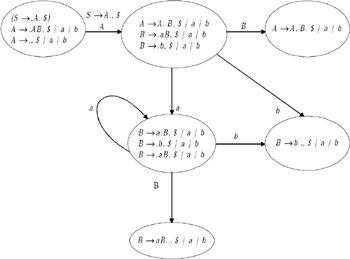
Figure 5.21: Collection of nonempty sets of LR(1) items for Example 5.7.
EAN: 2147483647
Pages: 108